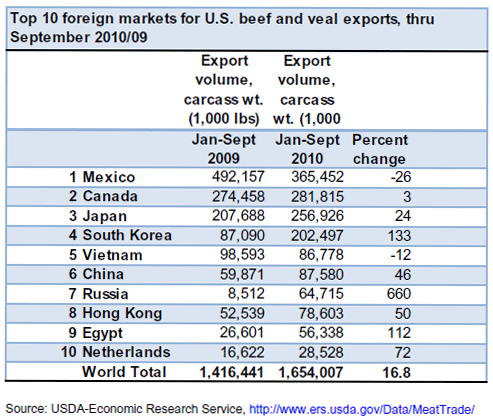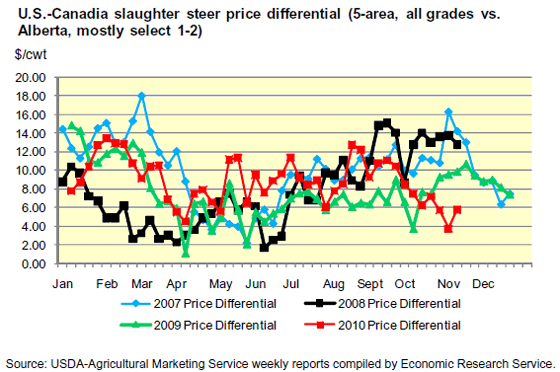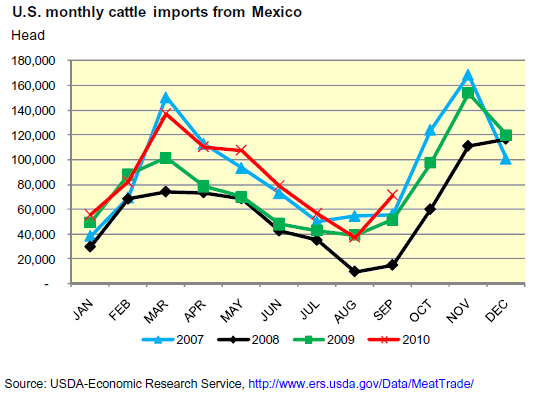



Livestock, Dairy, and Poultry Outlook - November 2010
Beef exports are expected to continue in an upward trend, whilst milk production is expected to be limited due to soaring feed costs according to the latest Livestock, Dairy, and Poultry Outlook from the USDA's Economic Research Service.
Beef/Cattle: Continued heavy cow slaughter and high placements of heifers in feedlots keep a lid on cow herd expansion. Feedlots continue to place cattle despite higher corn prices and declining fed cattle prices, and packers continue to slaughter cattle at rates inconsistent with declining wholesale prices.
Beef/Cattle Trade: Beef exports for 2010 are forecast at 2.29 billion pounds, which is 17-percent growth year-over-year. Although demand for U.S. beef among major trading partners should be equally as strong, or stronger, next year, smaller production will tighten supplies and puts the export forecast for 2011 at 2.27 billion pounds. With the beef supplies of major U.S. beef trading partners also tight into next year, the outlook on imports for 2011 may be much the same as it has been this year.
Dairy: Higher feed prices will limit gains in milk production in 2011. Improving domestic demand and strong export prospects, especially for nonfat dry milk, should keep the all milk price in 2011 very near this year’s expected average. Imports are forecast lower next year. Exports on a fats basis are expected to decline next year, while exports on a skim-solids basis will remain strong.
Beef/Cattle
Corn and Cattle Prices Generate Confusing Signals
Federally inspected cow slaughter is at its highest level in more than a decade, and this slaughter has been based on the lowest cow inventories since the early 1950s. The total quantity of beef produced per cow (January 1 inventories) in the United States has grown significantly over this same period from 310 pounds (1956) to 633 pounds (2009), as has both domestic and international demand for U.S. beef. This high rate of cow slaughter will slow down at some point, but "when" is subject of much discussion. Several conflicting factors are motivating current slaughter decisions, among them relatively high cow, heifer, and grain prices, an uncertain economic situation for the near term, and current demand for ground beef products. Cow prices are declining, although slowly and from relatively high levels—a sign that cow-calf producers are cashing in while the money flows. When the decision is made to expand, the first sign of herd expansion could show up as a reduction in cow slaughter. Because of anticipated higher prices for heavy feeder cattle, including heifers, this reduced cow slaughter could occur even before extra heifers are kept.
With high corn prices, lower prices for light feeders—especially for calves, which are typically discounted relative to yearlings of the same weight—will not encourage cow-calf producers to expand their herds before sometime in 2011. It is difficult for cow-calf producers to think about herd expansion when the typical discounts for heifers relative to steers and the inverse relationship between prices and weights are atypically small (see Stocker Cattle Production, August 2009 newsletter). Among these heavy-weight cattle are heifers that might have been retained for breeding. Forgoing the income from sales of these heifer is not a decision most producers are apt to make at present, and this will likely put off serious thoughts of herd expansion for at least the next year. Even if producers were to begin holding heifers back for replacements in 2011, the heaviest of these heifers would be counted as replacement heifers on January 1, 2011, but wouldn't count as cows until after January 1, 2012. Holding heifers back as replacements would also reduce the number of heifers going to feedlots, which would reduce beef production.
Net placements could drop off significantly beginning sometime early in the fourth quarter, if the following circumstances persist: First, net placements beginning in March 2010 have been larger year-over-year, with July the sole exception. As a result, feeder cattle supplies outside feedlots are lower year-over-year by almost 4 percent. Second, although there remains some potential for pulling feeder cattle forward for feedlot placement, the relatively high corn prices may temper these placements, especially if fed cattle prices come under pressure from placements over the last several months. Third, the demand for lighter weight wheat-pasture calves will likely provide some support for feeder cattle prices, another negative for net feeder cattle placements in the face of high corn prices if wheat pasture continues to be available for most of the winter.
While feeder cattle placements have been relatively large in year-over-year terms, they have been distributed somewhat bimodally, with larger shares of cattle coming from both ends of the weight spectrum—the lightest and heaviest—rather than from the usual mid-700-pound range. One possible result of these placement patterns is an effect on marketing patterns as these cattle come to market.
If cattle feeders withhold finished cattle from the market in an attempt to capture higher prices, cattle will gain extra finish and weight, which has the effect of smoothing the supply of fed cattle—with accompanying negative price pressure. These cattle would then be marketed during a period where, otherwise, finished cattle would have been in relatively short supply. This shift in marketing patterns could increase beef supplies and create downward pressure on prices throughout the cattle and beef complex.
If corn prices were to increase enough, heavy feeder cattle could sell at premiums to lighter cattle—a situation already being seen in spots. If wheat pasture remains available all winter, feeder cattle for placement in the first quarter 2011 could be scarce. Cattle feeders could begin attempting to pull these scarce supplies of feeder cattle forward into feedlots, although corn price levels will affect this dynamic. If wheat pasture is less abundant than expected, leading to earlier placement of lighter-weight cattle, the resulting negative pressure on prices for light to midweight feeder cattle could keep negative pressure on heavier weight cattle, despite their scarcity.
It is hard to see how fed cattle prices could go much above $100 per cwt during the fourth quarter while producers are faced with steady-to-increasing pork and poultry prices. Packer margins are seasonally near or below break-even levels, so packers’ enthusiasm for high fed cattle prices will likely be diminished somewhat, although they will still try to keep lines moving to reduce overhead as much as possible, and retail prices, at $4.47 per pound—up by 1 percent over September and 8 percent over October 2009—continue to provide support. Pork and poultry prices will also dampen pressure for beef prices to rise due to lower beef supplies.
Beef/Cattle Trade
U.S. Beef Export Market More Bullish than Bearish
The U.S. beef export forecast for 2010 has been revised upward to 2.29 billion pounds. This export total is only 10 percent lower than the pre-BSE discovery record level in 2003 and demonstrates nearly 17 percent year-over-year growth. Third-quarter exports totaled 590 million pounds, 19 percent higher than yearearlier levels. Strong demand for U.S. beef abroad and a weaker U.S. dollar have largely fueled U.S. beef exports or, rather, total red meat exports this year. With continued economic improvement, this trend shows no signs of slowing into 2011. Furthermore, the strong export demand for beef has been pointed to as one of the dominant factors underpinning wholesale beef prices in the domestic market. U.S. beef exports to Japan and South Korea through the third quarter were 24 and 133 percent higher year-over-year, respectively. Exports to Taiwan and Hong Kong were 46 and 50 percent higher year-over-year.
Weekly FAS Export Sales Reports also show strong early fourth quarter increases in exports, particularly to Japan and Mexico. The yen continues to strengthen (averaging 81.74 JPY/USD in October and 81.34 JPY/USD thus far in November) to new highs. Weekly exports to Mexico—below 2009 levels so far this year— have increased in the fourth quarter from prior weekly levels, largely due to the elimination of compensatory import duties previously imposed on U.S. beef imports to Mexico. Weekly exports to Taiwan and Vietnam in October were also at their strongest to date. Year-over-year growth in U.S. beef exports to trading partners in Asia is anticipated for next year, as is growth to Canada due to decreased Canadian production. Increasing consumption of beef in Egypt should also provide strong support to imports of U.S. beef to that country next year. Total U.S. beef exports for 2011 are forecast at 2.27 billion pounds.

Modest Growth in Beef Imports Expected in 2011
The 2010 beef import forecast, at 2.44 billion pounds, is the smallest since 1997 and occurs during a year when imports from Oceania also decreased. Imports through the third quarter were 10 percent below year-earlier levels, and imports from Australia were 28 percent lower, year-over-year. In addition, imports from New Zealand, Brazil, Argentina, and Uruguay were all lower through the third quarter. Production in Oceania been lower in 2010, as slaughter has declined and carcass weights have decreased. Although production in Australia was higher in the third quarter, a strong Australian dollar helped push imports from Oceania during the month of September to the lowest level in over a decade. Historically, Canada vies with Australia as the largest exporter of beef to the United States. Canadian imports through September are 12 percent higher year-over-year. However, as is also the case in the United States, declining cattle inventories in Canada, along with the propensity for herd rebuilding and reduced cow slaughter, will constrain production and, subsequently, Canadian export potential next year. For much of this year, increased U.S. cow slaughter has offset the decline in imported processing beef, as year-to-date cow slaughter is up 4.2 percent.
Brazil is the only major world producer of beef for which production in is expected to expand in 2011; however, the United States only imports processed (prepared/preserved) beef from Brazil, and no processing plants in Brazil are currently eligible to export beef to the United States. Demand for beef in the United States should continue to strengthen next year, adding upward pressure on imports; however, with beef in tight supply among major U.S. beef trading partners, the outlook on imports for 2011 is expected to be much the same as it has been this year. Total U.S. beef imports for 2011 are forecast at 2.54 billion pounds, about 4 percent above the current-year forecast.
Cattle Imports 16 Percent Higher Through Third Quarter
Cattle imports through September totaled 1.6 million head, compared with the 1.4 million head imported through September last year. Import levels from both Canada and Mexico though the third quarter are above year-earlier levels by 7 and 30 percent, respectively. With the Canadian feeder market still trading at a premium to U.S. values, slaughter cattle have primarily been imported from Canada. The price differential between U.S. and Canadian slaughter cattle (5-Area, all grades vs. Alberta, mostly select, 1-2) has shown steady decline beginning in early September and since November has remained below the differential level of the past 3 years. Thus, coupled with the continued weakening of the U.S. dollar and with Canadian marketings set to decline in the fourth quarter, Canadian slaughter cattle imports to the United States through the end of the year should inevitably remain at lower levels.

Feeder imports from Mexico typically spike in the fall as forage in Mexico rapidly deteriorates. Recent strong weekly feeder cattle imports from Mexico indicate that import levels though the remainder of the year should follow the seasonal trend. Weekly AMS reports show imports of Mexican cattle near or above the 40,000 hd/week mark toward the end of October, with a historically high number of cattle (over 50,000 head) imported from Mexico during the first week in November. Additionally, U.S. feeder cattle prices remain well above the exchange rate-adjusted Mexican feeder price equivalent, as they have for much of this year. Currently in U.S. cattle markets, there is also a high value of gain priced into feeder markets for forage-based stocker production, also in light of higher corn prices. Current price relationships between different weights and classes of cattle are sending signals to stocker producers to increase production, and Mexican feeder imports are supplying some of this demand. Total cattle imports for 2010 are forecast at 2.2 million head, 10 percent above the 2009 level.

Dairy
Higher Feed Prices Will Likely Limit Milk Production Expansion in 2011 After This Year’s Rise
Current USDA forecasts call for substantially higher corn prices in 2010/11 compared with last year. Prices are projected at $4.80 to $5.60 per bushel, an increase from last month’s forecast and up sharply from last year’s $3.55 per bushel average. Soybean meal prices are forecast at $310 to $350 per ton this year, a small rise from last year’s $311 per ton average. Higher 2011 feed ingredient prices will boost the benchmark 16-percent protein mixed dairy ration by double digits after 2 years of declines. The upward movement in feed prices will pressure producer margins and will likely curtail the modest recovery in cow numbers that began early this year. For 2011, cow numbers are forecast at 9,130 thousand head, up slightly from 9,115 thousand expected this year. Milk output per cow is projected to rise by better than 2.8 percent in 2010. The expected rise this year can be attributed to relatively moderate feed prices and overall good weather. Next year, forecast higher feed prices will likely bring down the expected increase to about 1.3 percent, close to trend. Despite the higher feed price forecast, milk production is forecast to climb to 195.6 billion pounds in 2011, a rise of more than 1.4-percent over this year’s projected 192.8 billion pound production.
Milk equivalent exports on a fats basis have shown strength this year. Cheese exports have been robust this year; however, continued growth may be limited by tariffs on exports to Mexico. Total exports on a fats basis are expected to total 7.7 billion pounds this year and decline to 6.2 billion pounds in 2011. Exports on a skim-solids basis are forecast to total 29.8 billion pounds this year and continue strong in 2011, reaching 29.5 billion pounds by year-end. Global economic recovery and a weaker dollar should help support nonfat dry milk (NDM) exports.
The modest domestic economic recovery and a weaker dollar relative to foreign currencies will result in lower imports this year compared with last and will likely keep imports below year-earlier levels into 2011. Fats basis imports will likely total 4.6 billion pounds in 2010 and slip to 4.1 billion pounds next year. On a skimsolids basis, import totals are expected to be near 5.1 billion pounds this year, declining to 4.9 billion pounds in 2011.
Cheese prices have increased over the course of 2010 and are expected to average $1.515 to $1.525 per pound for the year. Cheese prices have fallen of late, but continued economic recovery, combined with slower growth in milk production, will firm cheese prices over the course of 2011. Next year, cheese prices are expected to average $1.530 to $1.620 per pound. Butter prices appear to have retreated from their peaks earlier in 2010 but will average $1.710 to $1.740 per pound for the year. In 2011, slightly higher milk production could lower butter prices even further. However, butter prices will remain high compared with recent years and are forecast to average $1.500 to $1.620 per pound. Export prospects for NDM will likely strengthen prices in 2011 to $1.185 to $1.255 per pound; up from this year’s expected $1.155 to $1.175 per pound average. Whey prices are expected to remain virtually unchanged, averaging 36.5 to 37.5 cents per pound this year and 35.5 to 38.5 cents per pound next year.
Stronger NDM prices should partly offset lower butter prices, keeping Class IV prices firm over the course of 2011. Class IV prices, which are expected to average $14.45 to $15.45 per cwt in 2011, will be only slightly lower than the expected $15.05 to $15.25 per cwt average in 2010. Stronger domestic demand for cheese will boost the Class III price next year. In 2011, the Class III price is expected to average $14.40 to $15.30 per cwt, up from an average $14.35 to $14.45 this year. The all milk price is forecast to average $15.95 to $16.85 per cwt next year, very near the expected 2010 average of $16.30 to $16.40 per cwt.
Further Reading
| - | You can view the full report by clicking here. |
November 2010


